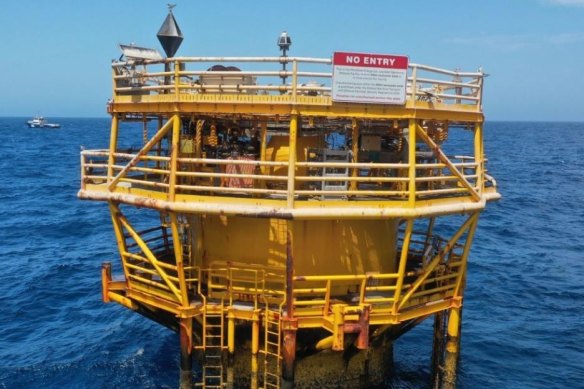This was published 1 year ago
Woodside’s toxic risk oil tower slowly sinking near Ningaloo Reef
By Peter Milne
A steel tower likely containing toxic chemicals once used by Woodside to produce oil near Western Australia’s Ningaloo Reef is slowly sinking after poor maintenance delayed its removal for four years.
Woodside has been ordered to take “all reasonable measures” to ensure the floating tower 16 kilometres from the Ningaloo World Heritage Area does not become a collision risk for ships or damage the environment.

The riser turret mooring weighs 2500 tonnes and is 83m long.
Offshore regulator NOPSEMA issued the direction to Woodside in late December after a structure called a riser turret mooring sank 1.5 metres lower in the water in October due to water leaking into a compartment, and then dropped a further 0.2 metres.
“NOPSEMA is of the opinion that the integrity of the riser turret mooring has been further compromised and is at risk of submerging or sinking,” a spokesman for the regulator said.
The 83 metre-high floating tower connected the Nganhurra oil production vessel to chains anchored to the seabed until the vessel was towed away in 2018 after operating for 17 years.
Woodside originally planned to tow the tower to Perth for disposal within six months, but a flooded compartment and malfunctioning valves meant the vertical tower could not be moved to a horizontal position required for the more than 1000-kilometre trip.
The regulator said the problems demonstrated Woodside, which had skipped a planned 10-yearly inspection of the compartments, had not maintained the tower properly.
NOPSEMA has been investigating for two years whether Woodside’s poor maintenance was a breach of the law.
Woodside’s next plan was a short tow to two kilometres outside the Ningaloo Marine Park, where the tower would be sunk to form part of an artificial reef to attract fish for recreational fishers.
However, the federal Department of the Environment concluded the plan presented “a material risk to the marine ecosystems” and “risks to human health cannot be ruled out”, according to documents obtained via a freedom of information request by the Australian Conservation Foundation.
The problem was 65 cubic meters of polyurethane foam in the tower thought to contain up to 120 kilograms of fire retardant chemicals called PBDEs that are associated with loss of IQ. The department concluded they could affect humans who ate fish caught at the planned artificial reef.
Woodside has now reverted to disposing of the tower at the Henderson industrial area south of Perth, but it will now be lifted onto a barge, not towed through the water.
A Woodside spokeswoman said it would act to increase the buoyancy of the tower in the coming weeks, plans to remove the tower in late 2023 and early 2024, and until then, comply with the regulator’s direction to minimise risks to the environment and shipping.
If the tower continues to sink, there is a risk it will end up on the seabed before the planned removal. The Woodside spokeswoman said if that happened the company was committed to retrieving the tower.
Greenpeace campaigner Richard George said Woodside had made billions exporting Australia’s gas but left a trail of accidents, near misses and shoddy clean-up in its wake.
“If Woodside thinks it’s too expensive or too hard to clean up the mess it’s made in Western Australia’s oceans then it can’t be trusted not to make an even bigger mess drilling for new gas at Scarborough and Browse.”
Australia’s offshore oil and gas industry faces a $55 billion bill by 2050 to remove its equipment from the ocean.
The Enfield oil field where the tower is located is operated by Woodside and is 40 per cent owned by Mitsui, which also runs the Waitsia onshore gas field north of Perth.